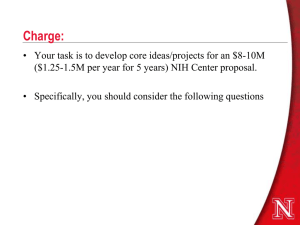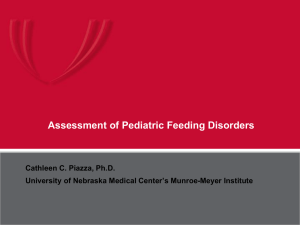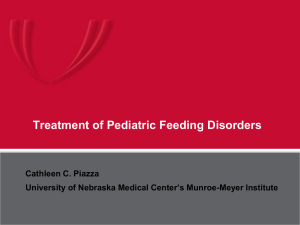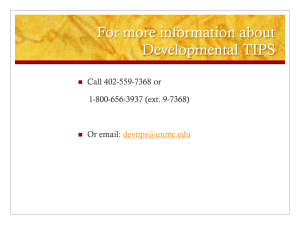Behavioral Approaches to the Treatment of Autism
advertisement
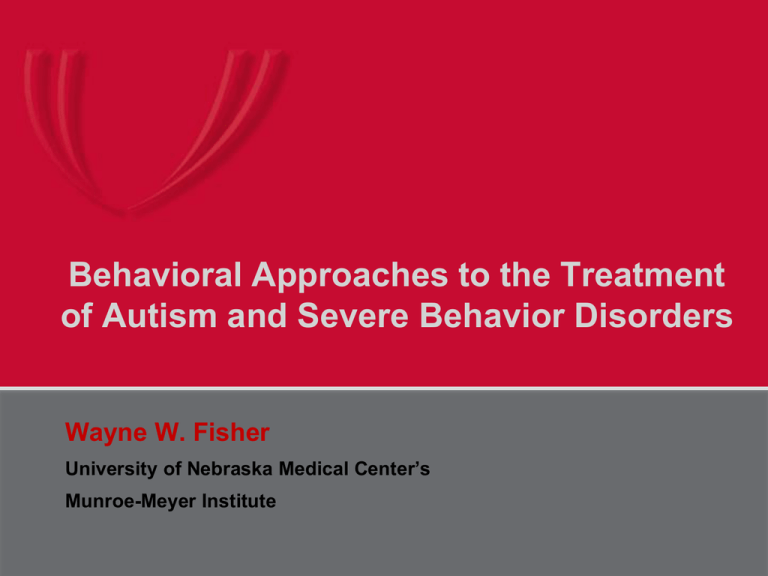
Behavioral Approaches to the Treatment of Autism and Severe Behavior Disorders Wayne W. Fisher University of Nebraska Medical Center’s Munroe-Meyer Institute UNMC Munroe-Meyer Institute Autism and Childhood Schizophrenia Once thought to be a form of schizophrenia Differs from schizophrenia in terms of symptoms, age of onset, family history, etiology, and response to treatment UNMC Munroe-Meyer Institute Definition of Autism markedly abnormal or impaired development in: 1. social interaction 2. Communication and markedly restricted repertoire of activities and interests. UNMC Munroe-Meyer Institute Definition of Autism Definitions are cheap, but explanations are dear, and we must be careful not to confuse them. » David Palmer, 2004 UNMC Munroe-Meyer Institute Prevalence of Autism Typically diagnosed within first three years Recent estimate indicate that the prevalence of ASD is between 1 in 38 and 1 in 88 Four times more prevalent in boys than girls UNMC Munroe-Meyer Institute Recurrence Risk for Siblings If an older sibling has and autism spectrum disorder, the risk for a Younger brother is 1 in 4 Younger sister is 1 in 11 UNMC Munroe-Meyer Institute NIH Research Dollars Devoted to Autism When Compared with Other Serious Childhood Conditions, Autism is Much More Common, but Fewer Dollars Per Case are Spent on Autism. UNMC Munroe-Meyer Institute Prevalence of Autism and Other Conditions 70 (Number of Cases per 10,000 Children) 60 50 40 30 20 10 0 Autism Juvenile DiabetesMuscular Dystrophy Leukemia Cystic Fibrosis UNMC Munroe-Meyer Institute NIH Research Dollars for Autism and Other Conditions (Number of Dollars per Case) $140,000 $120,000 $100,000 $80,000 $60,000 $40,000 $20,000 $Autism Juvenile Diabetes Muscular Dystrophy Leukemia Cystic Fibrosis UNMC Munroe-Meyer Institute Unfortunately, you have what we call “no insurance.” UNMC Munroe-Meyer Institute Demographics of Autism Affects all racial, ethnic, and national groups Family income, lifestyle, and educational levels do not affect the chance of autism's occurrence Diagnosis of autism is growing at a rate of 1017 percent per year (U.S. Department of Education, 2002) UNMC Munroe-Meyer Institute Assessment and Diagnosis of Autism No medical tests for diagnosing autism Accurate diagnosis is based on observation of the individual's communication, behavior, and developmental levels. Autism Diagnostic Interview-R (ADI-R) Autism Diagnostic Observation Schedule (ADOS) Home and/or school observation Video analysis of behavioral observation UNMC Munroe-Meyer Institute Social Behavior Generally Requires Little or No Explicit Training UNMC Munroe-Meyer Institute Assessment and Acquired Autism Autism is most often diagnosed between 2 and 5 years of age. Thus, it is natural for parents to look for environmental events occurring shortly before this time that may have caused the autism, such as childhood vaccines. UNMC Munroe-Meyer Institute MMR Vaccines and Autism 10 of the original 13 authors of the investigation that started the controversy have retracted the study’s interpretation, as has the journal, The Lancet Prevalence rates of autism are equivalent in children who have and have not been vaccinated. Increases in the prevalence of autism did not abate when thimerosal was removed from vaccines. Regression in autism is no more likely in the months after the MMR vaccine than in the months before the vaccine. UNMC Munroe-Meyer Institute Identifying the Genetic Bases of Autism Spectrum Disorders Etiologic Workups Identify Specific Genetic Causes for Autism in About 20% of Cases. At the Munroe Meyer Institute, Shaefer and Colleagues (2006) have developed a 3-Tiered Approach that Identifies Genetic Causes in 40% of Cases. UNMC Munroe-Meyer Institute Associated Disorders Autism ASD Mental Retardation 50% 15% Seizure Disorder 35% 10% Self-Injury, Aggression 50% Tourette Disorder Bipolar Disorder UNMC Munroe-Meyer Institute Associated Etiologic Diagnoses Fragile-X syndrome Tuberous Sclerosis Williams syndrome Landau-Kleffner syndrome Congenital Rubella Smith-Magenis syndrome Neurofibromatosis UNMC Munroe-Meyer Institute Genetics and Twin Studies Autism runs in families Heritability for autism is about 90% Monozygotic twin concordance, 60%-100% Dizygotic twin concordance, 10% Associated with abnormalities on chromosomes 7q, 2q, and 15q UNMC Munroe-Meyer Institute Applied Behavior Analysis (ABA) What is ABA? How is it different from other approaches? How is it Done? UNMC Munroe-Meyer Institute How Effective is ABA for Autism? About 50% of Children with Autism and no More than Mild Mental Retardation who Receive Early Intervention with ABA Attain Normal IQs and are Educated in Regular Classrooms with Minimal Assistance. UNMC Munroe-Meyer Institute Outcomes of ABA for Autism 35 Increases in IQ Scores 30 25 20 15 r = .79 p < .02 10 5 0 0 5 10 15 20 25 30 Hours per Week of Treatment 35 40 45 UNMC Munroe-Meyer Institute Cost-Benefit Analysis of Early, Intensive ABA for Autism Average Lifetime Cost for a Person with Autism is over $4 million Average cost of Early, Intensive ABA is $150,000 over about 3 years Average Lifetime Savings from ABA Treatment is Between $1.6 and $2.7 million UNMC Munroe-Meyer Institute Cost-Benefit Analysis of ABA treatment for Severe Behavior Disorders Children with Autism and Severe Destructive Behavior Cost $8 million over a lifetime. Keeping just one child out of chronic care pays for treatment of hundreds more. Our treatment approach has over an 80% success rate. Case Example 4000 $4,050,000 (Costs since 1986) 3500 Dollars in Thousands 3000 2500 2000 1500 1000 500 $85,924 0 Inpatient and Outpatient Costs Residential Costs Over 25 Years UNMC Munroe-Meyer Institute Autism and Problem Behavior 98% of children with autism have one or more of the following problems: 1. Feeding problems 2. Sleeping problems 3. Tantrums 4. Self-injurious behavior 5. Aggression Dominick et al. (2007) UNMC Munroe-Meyer Institute UNMC Munroe-Meyer Institute Variables Related to Problem Behavior in Autism Lower IQ scores were associated more problem behaviors Lower expressive language scores were associated with more problem behaviors Increased social deficits were associated with more problem behaviors Dominick et al. (2007) UNMC Munroe-Meyer Institute UNMC Munroe-Meyer Institute UNMC Munroe-Meyer Institute UNMC Munroe-Meyer Institute UNMC Munroe-Meyer Institute Functional Analysis and Treatment of Aberrant Behavior UNMC Munroe-Meyer Institute Structural vs. Functional Diagnosis Structural Approach 1. How often a particular set of symptoms or responses cluster or covary. Functional Approach 1. Whether and which environmental variables influence the response. UNMC Munroe-Meyer Institute Functional Analysis Identifies the environmental contexts in which aberrant behavior is likely and unlikely. Identifies the consequences that reinforce and maintain the behavior. Used to prescribe effective treatments. UNMC Munroe-Meyer Institute Common Functions of SIB Social Positive Reinforcement (Attention, Tangible items) Social Negative Reinforcement (Escape) Automatic Reinforcement (e.g., Sensory Stimulation) UNMC Munroe-Meyer Institute Essential Features of Functional Analysis Conditions Unique discriminative stimuli that signal the available of a specific reinforcer Establishing operation (EO) that increases motivation for the specific reinforcer 1. An EO is an environmental condition that momentarily increases the effectiveness of a reinforcer and that evokes responses that have produced that reinforcer in the past. Contingency between the target behavior and the specific reinforcer UNMC Munroe-Meyer Institute Identifying the Essential Features of Functional Analysis Conditions See if you can identify the discriminative stimulus, the establishing operation, and the reinforcement contingency in each of the following functional analysis conditions. UNMC Munroe-Meyer Institute Attention Condition Adult is busy reading. Child is expected to play quietly with toys. Adult attention shifts to child following SIB (e.g., “Please don’t hit yourself”). Determines whether adult attention functions as reinforcement for SIB. UNMC Munroe-Meyer Institute Essential Features of the Attention Condition Discriminative Stimulus: Adult is seated in a chair reading a book. EO: Attention is unavailable. Contingency: SIB produces attention. UNMC Munroe-Meyer Institute Tangible Condition Adult takes preferred toys or leisure materials from the child and returns them following SIB. Determines whether access to preferred items functions as reinforcement for SIB. UNMC Munroe-Meyer Institute Essential Features of the Tangible Condition Discriminative Stimulus: Adult takes and holds the preferred tangible item at the start of the session. EO: Tangible item is unavailable in the absence of SIB. Contingency: SIB produces the tangible item. UNMC Munroe-Meyer Institute Demand Condition Child is prompted to complete nonpreferred tasks by an adult. The task is removed and the child is given a short break following SIB. Determines whether termination of non-preferred activities functions as reinforcement for SIB. UNMC Munroe-Meyer Institute Essential Features of the Demand Condition Discriminative Stimulus: Instructional materials and demands are presented. EO: Nonpreferred demands are presented. Contingency: SIB results in temporary removal of the demands. UNMC Munroe-Meyer Institute Alone Condition Child is placed in a room alone without toys or materials. Indirectly assesses whether SIB may be maintained by automatic reinforcement (e.g., sensory stimulation). UNMC Munroe-Meyer Institute Essential Features of the Alone Condition Discriminative Stimulus: Absence of another individual or materials. EO: Alternative sources of stimulation are unavailable. Contingency: SIB produces selfstimulation. UNMC Munroe-Meyer Institute Toy Play Condition Child and adult play together with preferred toys or leisure items. Adult delivers praise about once every 30 seconds for the absence of SIB. Designed to be an analogue of an “enriched environment”, which serves as a control condition. UNMC Munroe-Meyer Institute Essential Features of the Toy Play Condition Discriminative Stimulus: Adult and toys are near the individual. EO (or AO): Attention and tangible items (toys) are freely available and no demands are presented. Contingency: SIB produces no consequence. Per Minute Aggressive Responses 3 Attention 2 Ignore 1 Tangible Demand Play 0 1 3 5 7 9 11 13 15 17 19 21 23 Sessions 25 27 29 31 33 35 37 39 8 Baseline FCT + Baseline Extinction FCT + Extinction Destructive Behavior Response per Minute 6 4 Kirk Communication 2 0 1 2 3 4 5 6 7 8 9 10 11 12 13 14 15 16 17 18 19 20 21 Session UNMC Munroe-Meyer Institute Functional Analysis of Covert Drug Ingestion Three Operant Hypotheses Generated After Caregiver Interview and Chart Review 1. Attention/Excitement From Medical Procedures 2. Attention From Mother 3. Escape From Work Activities UNMC Munroe-Meyer Institute Functional Analysis of Covert Drug Ingestion (cont.) Sessions Conducted in a Classroom and an Adjoining Medication Room Baited With Placebos in a Pillbox. Patient was Left Unsupervised in the Classroom With a Schoolwork Assignment. UNMC Munroe-Meyer Institute Functional Analysis of Covert Drug Ingestion (cont.) In the Pillbox Were Four Pill Bottles Containing Placebos. Each Pill Bottle had a Uniquely Colored Label. Consuming Pills From Each Pill Bottle Produced a Specific Consequence. UNMC Munroe-Meyer Institute Functional Analysis of Covert Drug Ingestion (cont.) Red = Medical Attention Orange = Attention From Mother Blue = Rest Period (Escape) Yellow = Control (Ignore) PILLS INGESTED PER MINUTE 20 Escape From Work 15 Parent Attention 10 5 Control Medical Attention LYLE 0 1 5 10 15 SESSIONS FUNCTIONAL ANALYSIS UNMC Munroe-Meyer Institute Treatment of Escape-Maintained Drug Ingestion Lyle Earned Preferred, Nonwork Activities for Completing Scheduled Activities and Turning in Pills. He was Required to Complete His Least Preferred Work Activity (Shoe Polishing) if He Ingested Pills. UNMC Munroe-Meyer Institute PILLS INGESTED PER MINUTE 20 Baseline Treatment Baseline Treatment 15 10 5 LYLE 0 10 20 30 40 50 60 70 80 SESSIONS TREATMENT ANALYSIS UNMC Munroe-Meyer Institute Treatment Extension of EscapeMaintained Drug Ingestion Lyle was Gradually Exposed to Different Settings where He was Observed and Supervised Less. Detection Methods Were Faded From Direct Observation to Pill Bottles With Residue and Then to Weekly Tox Screens. UNMC Munroe-Meyer Institute Functional Communication Training (FCT) Functional communication training (FCT) is a treatment commonly prescribed when a functional analysis has shown that an individual’s problem behavior is maintained by social consequences (e.g., Carr & Durand, 1985; Fisher et al., 1993; Horner, Day, Sprague, O’Brien, & Heathfield, 1991; Lalli, Casey, & Kates, 1995; Wacker et al., 1990). UNMC Munroe-Meyer Institute Functional Communication Training (FCT) With FCT, the individual is taught a communicative response that produces access to the reinforcer responsible for maintenance of the problem. For example, an individual whose problem behavior is maintained by escape from tasks might be taught to request a break by signing ‘‘finished’’ (e.g., Hagopian, Fisher, Sullivan, Acquisto, & LeBlanc, 1998). UNMC Munroe-Meyer Institute Unique Features of FCT FCT is a DRA procedure that: 1. specifies its reinforcer (i.e., a mand specifying the reinforcer that previously maintained problem behavior), 2. requires minimal response effort, 3. is initially reinforced on a dense schedule (e.g., FR 1), 4. can recruit reinforcement across environmental contexts. UNMC Munroe-Meyer Institute Unique Features of FCT Because of the ease and consistency with which reinforcement can be obtained during FCT, some authors have suggested that the client ‘‘controls’’ the delivery of reinforcement (e.g., Carr & Durand, 1985). In addition, Carr and Durand suggested that “control over reinforcement,’’ contributed to the effectiveness of FCT. UNMC Munroe-Meyer Institute Unique Features of FCT Two investigations found that noncontingent reinforcement (NCR), which does not allow the client to control the schedule of reinforcement, and FCT, which does, produced equivalent reductions in problem behavior (Hanley, Piazza, Fisher, Contrucci, & Maglieri, 1997; Kahng et al., 1997). Nevertheless, we found that participants preferred FCT over NCR when given a choice (Hanley et al., 1997). UNMC Munroe-Meyer Institute Unique Features of FCT FCT may promote generalization and maintenance because the communication response may prompt both trained and untrained caregivers to deliver differential reinforcement appropriately (e.g., Durand & Carr, 1991). UNMC Munroe-Meyer Institute Limitations of FCT Teaching the FCT response may evoke problem behavior (particularly if it is maintained by escape). Individuals may display the FCT response at exceedingly high rates (e.g., requesting a break from every school task). Individuals may request reinforcement at times when it is impossible or inconvenient to deliver (e.g., caregiver tending to an infant sibling). UNMC Munroe-Meyer Institute Selecting the Functional Communication Response (FCR) The FCR should be simple. The FCR should produce the reinforcer identified during the functional analysis. The FCR should quickly remove the establishing operation for problem behavior. UNMC Munroe-Meyer Institute Training the Communication Response The communication response matches the function of the child’s problem behavior. 1. Demand -> “Break please.” 2. Attention -> “Play with me, please.” 3. Tangible -> “Toy please.” UNMC Munroe-Meyer Institute Training the Communication Response Children who do not speak are often taught to use a picture-exchange communication response. 1. Attention -> Child hands over a picture of the adult and child playing together. 2. Demand -> Child hands over a picture of the child leaving a work table. UNMC Munroe-Meyer Institute Function-Based Extinction EXT (Att): Attention no longer follows the target behavior EXT (Tang): Tangible item is longer presented following the target behavior EXT (Esc): Demands continue following the target behavior EXT (Auto): The sensory consequences of the target response are eliminated or the response is prevented. UNMC Munroe-Meyer Institute Stimulus Control Refinements of FCT Controlling the establishing operation for problem behavior is particularly important during the early stages of treatment. Bringing the functional communication response under tight discriminative control is particularly important for increasing the practicality and generality of FCT. UNMC Munroe-Meyer Institute Study 1: Does strict control of exposure to the establishing operation (EO) for problem behavior facilitate the effectiveness of FCT? We compared FCT using a picture exchange (or card touch) as the FCR with a vocal FCR. The picture exchange version of FCT (FCT-card) allows strict control of the EO, because the therapist can immediately guide the FCR and deliver the reinforcer, which removes the EO. The vocal version of FCT (FCT-vocal) does not allow strict control of the EO, because one cannot guide a vocal response. UNMC Munroe-Meyer Institute Study 1: Procedures Following baseline, the two FCT treatments (FCT-card and FCT-vocal) were both introduced using a progressive time-delay procedure to teach each FCR. The two treatments were compared using a multielement phase. Following a return to baseline, the more effective treatment was re-introduced in the final phase. t = 3.0; p = .01 UNMC Munroe-Meyer Institute Study 1: Conclusions The FCT-card card condition allowed better control of the EO for problem behavior. The FCT-card condition produced more rapid reductions in problem behavior. The FCT-vocal condition was associated with an extinction burst for one participant, which was not observed in the FCT-card condition. UNMC Munroe-Meyer Institute Controlling the EO While Training the Communication Response When FCT is initiated, the communication response should always produce the reinforcer. If the child cannot do the response independently, we help them and then immediately deliver the reinforcer. UNMC Munroe-Meyer Institute Stimulus Control Refinements of FCT Controlling the establishing operation for problem behavior is particularly important during the early stages of treatment. Bringing the functional communication response under tight discriminative control is particularly important for increasing the practicality and generality of FCT. UNMC Munroe-Meyer Institute Schedule Thinning During Functional Communication Training Signaled and unsignaled delayed reinforcement (Vollmer et al., 1999) Activities or alternative reinforcers during the reinforcement delays (Fisher et al., 1998; 2000) Multiple schedules with reinforcement and extinction components (Betz et al., 2913; Fisher et al., 1998; Hanley et al., 2001) UNMC Munroe-Meyer Institute UNMC Munroe-Meyer Institute Typical Multiple-Schedule Training During FCT Quasi-random alternation between and FR-1 schedule and EXT for communication Each component correlated with a specific signal Initially, the duration of the reinforcement component is 3 to 4 times longer than the EXT component Gradually, the EXT component is lengthened relative to the SR+ component = FR1 FADING STEPS 1 45 s 2 60 s 3 60 s 4 5 6 60 s 60 s 60 s 7 60 s 8 60 s = Extinction 15 s 30 s Decreases reinforcer deliveries by about 75% 45 s 60 s 90 s 120 s 180 s 240 s UNMC Munroe-Meyer Institute Purpose To identify the necessary and sufficient components for the reinforcement schedule thinning 1. Study 2: Evaluated the effects of contingency-correlated stimuli during FCT 2. Study 3: Evaluated the necessity of systematic and gradual fading steps during schedule thinning under multiple schedule components 3. Study 4: Evaluated the extent to which contingencycorrelated stimuli facilitated generalization across therapists and environments UNMC Munroe-Meyer Institute Functional Analysis and FCT Treatment Evaluations Prior to Studies 2, 3, and 4, we conducted functional analyses to show that problem behavior was reinforced by social positive reinforcement for all participants. We also conducted treatment evaluations using an ABAB design to show that FCT was an effective treatment. UNMC Munroe-Meyer Institute UNMC Munroe-Meyer Institute UNMC Munroe-Meyer Institute UNMC Munroe-Meyer Institute Study 2: Are contingency-correlated stimuli necessary? Compared rates of FCR and problem behavior under equivalent mixed and multiple schedules using an ABAB design 1. Mixed FR-1:60 s / EXT:60 s 2. Multiple FR-1:60 s / EXT:60 s Data on problem behavior is not shown because it remained at near-zero levels throughout this study. UNMC Munroe-Meyer Institute Mixed vs. Multiple Assessment General Procedures 1. Sessions = 10 min 2. Contingency specifying stimuli in both conditions 3. FR1 = 60 s 4. Extinction = 60 s 5. All sessions started with reinforcement interval 6. All problem behavior was on extinction Multiple 4 Mixed Multiple Mixed 3 MANDS PER MINUTE CASEY 2 FR1: 60 s EXT: 60 s 1 0 0 5 10 15 20 SESSIONS -1 25 30 35 UNMC Munroe-Meyer Institute UNMC Munroe-Meyer Institute Study 3: Is schedule fading necessary? Compared rates of alternative and problem behavior when schedules were switched from rich to lean without schedule fading in a multiple baseline design Mult FR-1:60 s / EXT:60 s to Mult FR-1:60 s / EXT:240 s Mixed FR-1:60 s / EXT:60 s to Mult FR-1:60 s / EXT:240 s Data on problem behavior is not shown because it remained at near-zero levels throughout this study. UNMC Munroe-Meyer Institute UNMC Munroe-Meyer Institute UNMC Munroe-Meyer Institute Study 4: Do contingency-correlated stimuli facilitate generalization across therapists and settings? Compared rates of alternative and problem behavior when a multiple schedule was introduce across therapists or settings in a multiple baseline design Mixed FR-1:60 s / EXT:60 s to Mult FR-1:60 s / EXT:60 s Mult FR-1:60 s / EXT:60 s to Mult FR-1:60 s / EXT:300 s Data on problem behavior is not shown because it remained at near-zero levels throughout this study. University of Nebraska Medical Center University of Nebraska Medical Center University of Nebraska Medical Center UNMC Munroe-Meyer Institute Conclusions Study 2 showed that inclusion of contingencycorrelated stimuli was a necessary component of FCT schedule thinning. Study 3 showed that inclusion of contingency- correlated stimuli was sufficient to maintain appropriate responding without gradually fading the schedule density during FCT schedule thinning. Study 4 showed that contingency-correlated stimuli also facilitated generalization of FCT effects across therapists and settings. UNMC Munroe-Meyer Institute Study 5: How effective is Mult-FCT across a large cohort of patients with problem behavior? Hagopian et al. (1998) found that FCT with EXT (FCTE) failed in 14 of 25 cases during schedule thinning. 212 They also found that FCT with punishment (FCTP) reduced destructive behavior by 90% or more in all cases, even following reinforcer-schedule thinning. In the current study, we summarized the results of 14 applications of Mult-FCT implemented with 12 cases and compared the results with those of Hagopian et al. UNMC Munroe-Meyer Institute Amount of Reinforcer-Schedule Thinning The reinforcement schedule was thinned to the values listed below by rapidly lengthening the duration of the EXT component once the participant showed discriminated responding in Mult-FCT. 60/240: Seven applications (80% reduction in Sr+) 60/540: Six applications (90% reduction in Sr+) FR1/400: One application (> 90% reduction in Sr+) UNMC Munroe-Meyer Institute Calculating Percentage Reduction in Problem Behavior Percentage reductions in problem behavior were calculated using the following formula (same as in Hagopian et al. [1998]): Mean rate during last 5 sessions 1– Mean rate during baseline Percent Reduction in Problem Behavior UNMC Munroe-Meyer Institute 110 Hagopian et al. (1998) Current Data Set 100 90 80 70 60 50 40 30 20 10 0 n = 11 n = 17 n = 14 applications applications applications FCTE + Fading FCTP + Fading Mult-FCT + Fading UNMC Munroe-Meyer Institute Future Grants and Research on: Consequence Control Refinements of FCT Using behavioral momentum theory (BMT) and accompanying equations to prevent relapse and resurgence of problem behavior. BMT makes predictions that are at odds with current clinical “best practices”. UNMC Munroe-Meyer Institute Limitations of FCT (cont.) When a parent is busy and fails to deliver reinforcement for the child’s FCT response, the child is likely to revert to problem behavior, a phenomena called “resurgence”. Recent research has shown that resurgence of problem behavior is quite common, and problem behavior often occurs at pre-treatment levels when the FCT response goes unreinforced (Mace et al., 2010; Volkert et al., 2009). UNMC Munroe-Meyer Institute Mace et al., (2010) UNMC Munroe-Meyer Institute Volkert et al., (2009) UNMC Munroe-Meyer Institute Behavioral Momentum Theory Behavioral momentum theory is a quantitative theory of behavior that employs a comparative metaphor based on the classical mechanics of the momentum of physical objects. Behavioral momentum theory is relevant to FCT because it provides quantitative models and predictions about the persistence and resurgence of problem behavior when the FCT produces reinforcement and when it does not. UNMC Munroe-Meyer Institute The Momentum Metaphor In classical mechanics, the momentum of an object is a joint function of its mass and velocity. Momentum of a moving object = mass x velocity Momentum of a response = rate of reinforcement x response rate UNMC Munroe-Meyer Institute Equation 7 Predicts the Effects of Adding and Removing Reinforcement for the FCT Response UNMC Munroe-Meyer Institute Common Practice Guidelines for FCT Decreases may occur more rapidly during treatment if problem behavior is reinforced on a CRF schedule during baseline (Fisher & Bouxsein, 2011). “… we strongly recommend that the communicative response be reinforced on a CRF schedule initially (Tiger, Hanley, & Bruzek, 2008). Clinical guidelines on “dosage” levels of FCT are not available (i.e., How many sessions of FCT are needed before parent training and discharge?). UNMC Munroe-Meyer Institute Specific Recommendations of BMT The magnitude of resurgence predicted by Equation 7 is minimized by: 1. maximizing the value of t conducting many FCT sessions before exposure to an EXT challenge; 2. maximizing the value of d by correlating periods of reinforcement and EXT of the FCR with discriminative stimuli; UNMC Munroe-Meyer Institute Specific Recommendations of BMT The magnitude of resurgence predicted by Equation 7 is minimized by: 3. minimizing the value of r by delivering the lowest possible rate of reinforcement for destructive behavior during baseline; and 4. minimizing the value of Ra by delivering the lowest possible rate of reinforcement of the FCR during FCT. UNMC Munroe-Meyer Institute 300 Destructive Responses per Hour Baseline Extinction Challenge FCT (VI 30) (VI 20) 250 200 150 c = 1, d = .001, p = .05 Long Exposure (Room 1; Therapist = Purple) 100 Short Exposure (Room 2; Therapist = Yellow) 50 0 1 2 3 4 5 6 7 8 9 10 11 12 13 14 15 16 17 18 19 20 21 22 23 24 25 26 27 28 29 30 31 Session UNMC Munroe-Meyer Institute 250 Destructive Responses per Hour Baseline Extinction Challenge FCT (VI 36 s) 200 150 c = 1, d = .001, p = .05 100 VI 20 s (Room 1; Therapist = Red) VI 120 s* (Room 2; Therapist = Blue) 50 0 1 2 3 4 5 6 7 determined based on a progressive-interval assessment and may be different from a VI 120 s. *This lean schedule will be individually 8 9 10 Session 11 12 13 14 15 16 17 UNMC Munroe-Meyer Institute 250 Destructive Responses per Hour Baseline (VI 36 s) PI FCT Extinction Challenge 200 VI 20 s (Room 1; 150 Therapist = Green) c = 1, d = .001, p = .05 100 VI 180 s (Room 2; Therapist = Blue) 50 0 1 2 3 4 5 6 7 8 9 10 Session 11 12 13 14 15 16 17 UNMC Munroe-Meyer Institute 250 Destructive Responses per Hour Baseline EXT Challenge FCT 200 150 c = 1, d = .001, p = .05 Long Exposure of Alt VI 120 s* 100 (Room 1; Therapist = Red) VI 20 s (Room 2; Ther = Blue) Short Exposrue of Alt VI 20 s 50 (Room 2; Therapist = Blue) VI 120 s* (Room 1; Ther = Red) 0 1 *Lean 2 3 4 5 6 7 8 9 10 11 12 schedules to be individually determined based on PI assessments; they may be leaner or denser than VI 120 s. 13 14 15 16 17 18 Sessions 19 20 21 22 23 24 25 26 27 28 29 30 31 UNMC Munroe-Meyer Institute Concluding Comments Mathematical models like behavioral momentum theory provide a method for developing new and interesting clinical research questions that have the potential to greatly improve treatments like FCT. UNMC Munroe-Meyer Institute University of Nebraska Medical Center UNMC Munroe-Meyer Institute
